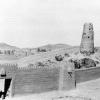-
Posts
38 -
Joined
-
Last visited
-
Days Won
4
Everything posted by Razeeni
-
You may find this is a special issue about Landsat 8 helpful: http://www.mdpi.com/journal/remotesensing/special_issues/landsat8
-
I hope you find these links helpful: PDF http://www.exelisvis.com/portals/0/pdfs/envi/Feature_Extraction_Module.pdf Youtube http://www.youtube.com/watch?v=EzzNmWIBaPk
-
This is another vendor http://www.spectralevolution.com/portable_spectroradiometer.html
-
Unfortunately, I don't know. You have to contact them for more information.
-
Jan 23, 2014 • [source: USGS Landsat] An incorrect bias adjustment for Thermal Infrared Sensor (TIRS) data was discovered in the latest release of the Landsat 8 processing system, which has caused a significant error in the TIRS products produced from Landsat 8 scenes acquired from January 14, 2014 to January 23, 2014. (The Operational Land Imager (OLI) bands are not affected.) All Landsat 8 scenes processed between January 14 and January 23 will be purged from the online cache and will become available for on demand order processing. An estimated 3 percent absolute radiometric error is observed and the errors do cause significant striping and banding in bands 10 and 11. More details are available on the Landsat 8 Calibration Notices webpage:http://landsat.usgs.gov/calibration_notices.php.
- 1 reply
-
- 1
-

-
What about http://www.oceanoptics.com/Products/spectrometers.asp ?
-
I don't think that you can avoid using RPC data. Your image is in pixel coordinate system, i.e. the origin point is located at the top left corner. You have to transform the image to image coordinate system (interior orientation) and finally to object coordinate system (exterior coordinate system). RPC data contains the coefficients necessary for these transformations. Best wishes.
-
Unfortunately, they didn't mention where are these images. But it is expected to be in USA.
-
These are sample images from micro satellite Sky Sat-1 by Skybox imaging. http://firstimagery.skybox.com
-
I hope you find these links helpful. http://www.academia.edu/574278/Dem_Creation_Using_ArcGIS http://education.usgs.gov/lessons/dem.pdf (go to part III). http://www.lib.uwaterloo.ca/locations/umd/documents/WorkingWithDEM-DTMinArcMap.pdf Youtube Link: http://www.youtube.com/watch?v=i9nGt5_Tdr4
-
Well, there are 1-m images for Dubai collected between 2003-2007 by OrbView-3. They are downloadable for free. You can find them at: earthexplorer.usgs.gov. I don't know any other website that offer such data with this level of spatial resolution. You may contact Dubai authorities for recent images.
-
Just go to File > Print In Print Map Composition window make sure that Print Destination is set to Image File. You'll get an image file with .img extension. Next, you can export this file to tiff format through Manage Data tap | Export Data. Regards.
-
I found this diagram in Erdas manual. I don't know if it is what you're asking about>
-
For the last question check the first box in this DOCUMENT.
-
"Landsat TM Band Combinations 3,2,1 This RGB combination simulates a natural color image. Sometimes used for coastal studies and detection of smoke plumes. 4,5,3 Used for the analysis of soil moisture and vegetation conditions. Also good for location of inland water bodies and land/water boundaries. 4,3,2 Known as false color Infrared; this is the most conventional band combination used in remote sensing for vegetation, crops, land use and wetlands analysis. 7,4,2 Analysis of soil and vegetation moisture content; location of inland water. Vetetation appears in shade of green. 5,4,3 Separation of urban and rural land uses; identification of land/water boundaries. 4,5,7 Detection of clouds, snow, and ice (in high latitudes especially). 4-3/4+3 NDVI Normalized Difference Vegetation Index; various ratios of TM bands 4:3 have proven useful for enhancing the contrast between vegetation types." Source: http://www.sfu.ca/geog452spring01/group3/data.html
-
I know it is an old news. http://www.sensysmag.com/spatialsustain/usgs-now-offers-orbview-3-high-resolution-images-for-free.html



